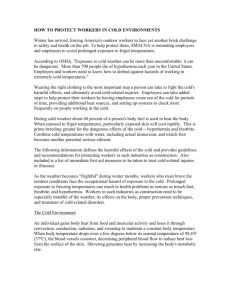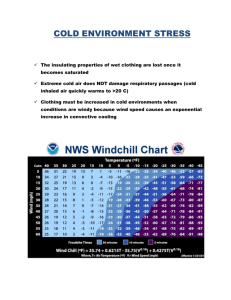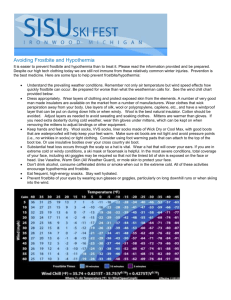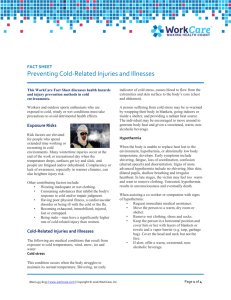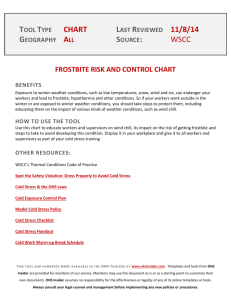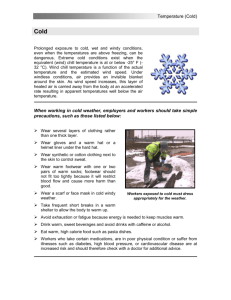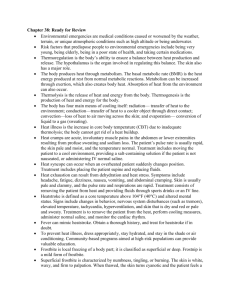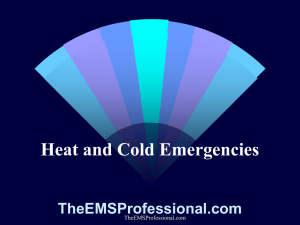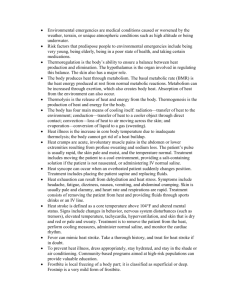harmful effects of cold: frostbite and hypothermia
advertisement
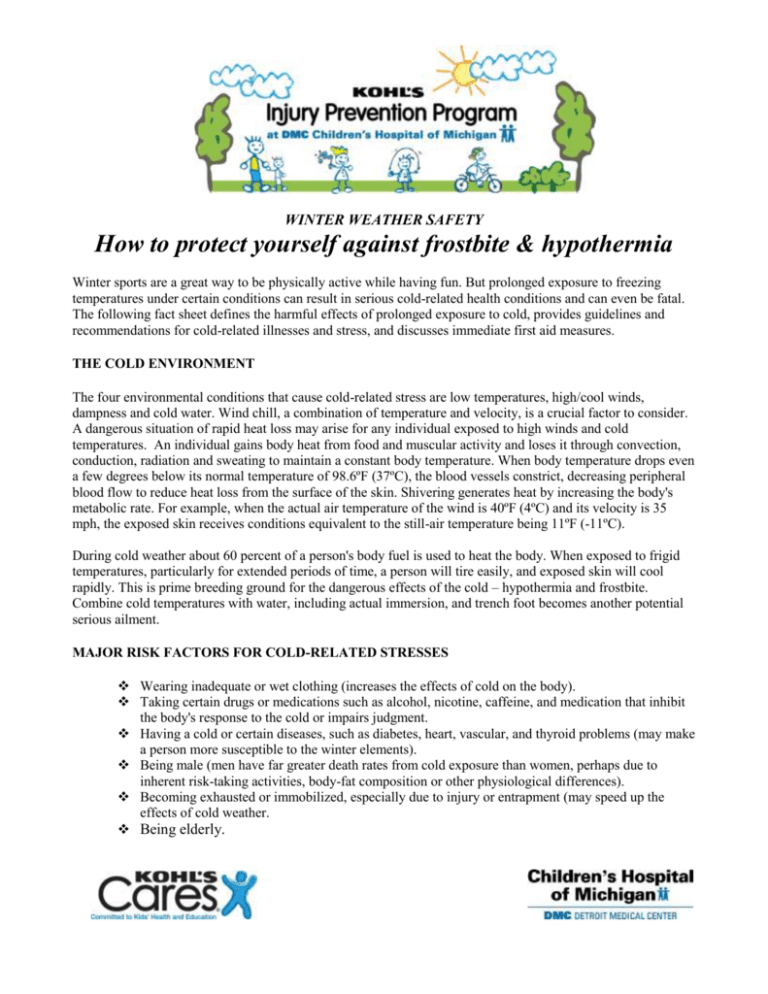
WINTER WEATHER SAFETY How to protect yourself against frostbite & hypothermia Winter sports are a great way to be physically active while having fun. But prolonged exposure to freezing temperatures under certain conditions can result in serious cold-related health conditions and can even be fatal. The following fact sheet defines the harmful effects of prolonged exposure to cold, provides guidelines and recommendations for cold-related illnesses and stress, and discusses immediate first aid measures. THE COLD ENVIRONMENT The four environmental conditions that cause cold-related stress are low temperatures, high/cool winds, dampness and cold water. Wind chill, a combination of temperature and velocity, is a crucial factor to consider. A dangerous situation of rapid heat loss may arise for any individual exposed to high winds and cold temperatures. An individual gains body heat from food and muscular activity and loses it through convection, conduction, radiation and sweating to maintain a constant body temperature. When body temperature drops even a few degrees below its normal temperature of 98.6ºF (37ºC), the blood vessels constrict, decreasing peripheral blood flow to reduce heat loss from the surface of the skin. Shivering generates heat by increasing the body's metabolic rate. For example, when the actual air temperature of the wind is 40ºF (4ºC) and its velocity is 35 mph, the exposed skin receives conditions equivalent to the still-air temperature being 11ºF (-11ºC). During cold weather about 60 percent of a person's body fuel is used to heat the body. When exposed to frigid temperatures, particularly for extended periods of time, a person will tire easily, and exposed skin will cool rapidly. This is prime breeding ground for the dangerous effects of the cold – hypothermia and frostbite. Combine cold temperatures with water, including actual immersion, and trench foot becomes another potential serious ailment. MAJOR RISK FACTORS FOR COLD-RELATED STRESSES Wearing inadequate or wet clothing (increases the effects of cold on the body). Taking certain drugs or medications such as alcohol, nicotine, caffeine, and medication that inhibit the body's response to the cold or impairs judgment. Having a cold or certain diseases, such as diabetes, heart, vascular, and thyroid problems (may make a person more susceptible to the winter elements). Being male (men have far greater death rates from cold exposure than women, perhaps due to inherent risk-taking activities, body-fat composition or other physiological differences). Becoming exhausted or immobilized, especially due to injury or entrapment (may speed up the effects of cold weather. Being elderly. WEARING THE RIGHT CLOTHING Wearing the right clothing is extremely important when participating in cold weather sports. Dress in layers, wearing warm, waterproof/resistant clothing. Clothing for cross-country skiing should protect the participant from cold, wind, and precipitation and should also provide ventilation—be "breathable". To reduce wind resistance, the clothing should fit snugly to the body. Pay special attention to protecting feet, hands, face and head. Up to 40 percent of body heat can be lost when the head is exposed. Footgear should be insulated to protect against cold and dampness. Wearing multiple layers of varying thickness allows you to regulate your body temperature. You should flexibly layer the clothing and use proper materials so you will stay warm and still not restrict your movement. Many peel off layers when cross-country skiing, and replace those layers when stopping to rest and rehydrate. Wear at least three layers of clothing. 1) An outer layer to break the wind and allow some ventilation (like Gore-Tex® or nylon). 2) A middle layer of wool or synthetic fabric (Qualofil or Pile) to absorb sweat and retain insulation in a damp environment. Down is a useful lightweight insulator; however, it is ineffective once it becomes wet. 3) An inner layer of synthetic weave to allow ventilation. Synthetic materials such as supplex and coolmax are ideal because they keep you warm and dry. HARMFUL EFFECTS OF COLD: FROSTBITE AND HYPOTHERMIA Frostbite occurs when the skin tissue actually freezes, causing ice crystals to form between cells and draw water from them, which leads to cellular dehydration. Although this typically occurs at temperatures below 30ºF (1ºC), wind chill effects can cause frostbite at above-freezing temperatures. Symptoms of Frostbite Initial effects of frostbite include uncomfortable sensations of coldness; tingling, stinging or aching feeling of the exposed area followed by numbness. Ears, fingers, toes, cheeks, and noses are primarily affected. Frostbitten areas appear white and cold to the touch. The appearance of frostbite varies depending on whether rewarming has occurred. Deeper frostbite involves freezing of deeper tissues (muscles, tendons, etc.) causing exposed areas to become numb, painless, hard to the touch. Treatment for Frostbite If you suspect frostbite, you should seek medical assistance immediately. Any existing hypothermia should be treated first (See hypothermia below). Frostbitten parts should be covered with dry, sterile gauze or soft, clean cloth bandages. Do not massage frostbitten tissue because this sometimes causes greater injury. Severe cases may require hospitalization and even amputation of affected tissue. Take measures to prevent further cold injury. If formal medical treatment will be delayed, consult with a licensed health care professional for training on rewarming techniques. Hypothermia General Hypothermia occurs when body temperature falls to a level where normal muscular and cerebral functions are impaired. While hypothermia is generally associated with freezing temperatures, it may occur in any climate where a person's body temperature falls below normal. For instance, hypothermia is common among the elderly who live in cold houses. Symptoms of Hypothermia The first symptoms of hypothermia, shivering, an inability to do complex motor functions, lethargy, and mild confusion, occur as the core body temperature decreases to around 95ºF (35ºC). As body temperature continues to fall, hypothermia becomes more severe. The individual falls into a state of dazed consciousness, failing to complete even simple motor functions. The victim's speech becomes slurred and his or her behavior may become irrational. The most severe state of hypothermia occurs when body temperature falls below 90ºF (32ºC). As a result, the body moves into a state of hibernation, slowing the heart rate, blood flow, and breathing. Unconsciousness and full heart failure can occur in the severely hypothermic state. Treatment of Hypotheria Treatment of hypothermia involves conserving the victim's remaining body heat and providing additional heat sources. Specific measures will vary depending upon the severity and setting (field or hospital). Handle hypothermic people very carefully because of the increased irritability of the cold heart. Seek medical assistance for persons suspected of being moderately or severely hypothermic. If the person is unresponsive and not shivering, assume he or she is suffering from severe hypothermia. Reduction of heat loss can be accomplished by various means: obtaining shelter, removal of wet clothing, adding layers of dry clothing, blankets, or using a pre-warmed sleeping bag. For mildly hypothermic cases or those more severe cases where medical treatment will be significantly delayed, external rewarming techniques may be applied. This includes body-to-body contact (e.g., placing the person in a prewarmed sleeping bag with a person of normal body temperature), chemical heat packs, or insulated hot water bottles. Good areas to place these packs are the armpits, neck, chest, and groin. It is best to have the person lying down when applying external rewarming. You also may give mildly hypothermic people warm fluids orally, but avoid beverages containing alcohol or caffeine. This information, developed by the U.S. Department of Labor, Occupational Safety and Health Administration (OSHA), has been adapted here for application to winter sports.
